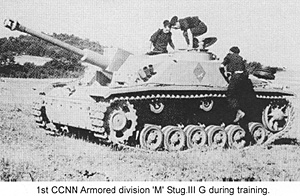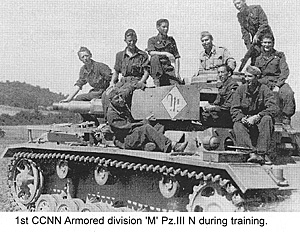 What follows is a description of the brief history of the first
and only CCNN (Camice Nere - Blackshirts) armored division
formed during WWII.
What follows is a description of the brief history of the first
and only CCNN (Camice Nere - Blackshirts) armored division
formed during WWII.
The Blackshirts were not part of the Regio Esercito (Royal Italian Army) and were formed on January 14, 1923, by Mussolini, with the name of Milizia Volontaria Sicurezza Nazionale (the MVSN - Volunteer Militia for National Security). At the beginning it was formed by the Fascist Party (Partito Nazionale Fascista) Squadre d'Azione.
On August 4, 1924, the MVSN was formally recognized as an Armed Force of the Italian State.
Mussolini expanded quickly the MVSN and in 1924 three Legions participated in the reconquest of Cyrenaica. Seven CCNN divisions participated in the Italo-Ethiopian War and three CCNN divisions in the Spanish Civil War.
During WWII, three CCNN divisions were quickly destroyed during the first Commonwealth offensive in North Africa. After this disaster, the CCNN never again formed divisionsized units, limiting themselves to regimental-sized formations (which fought anyway in every theater: Albania, Russia, Italian East Africa, North Africa, Greece, Italy, etc.).
Dissatisfied with the overall performances of the Regio Esercito and having the German SS divisions as a model, Mussolini decided to form an elite CCNN armored division.
On 12 April 1943, Enzo Galbiati, MVSN commander in chief, during a visit in Germany obtained directly from Heinrich Himmler the heavy equipment (tanks and 88mm AT guns) for the new formation. Himmler was 'kind' enough to also provide some SS Officers and NCOs to train the Italians in using the new equipment, following SS tactics.
At the beginning, it was decided to name the new division 'Littorio', using again the name of the famous regular Army armored division, destroyed during the El Alamein battle, but then the name changed to 'M', for 'Mussolini'.
It was formed during May 1943, and deployed near Rome.
It had an armored battalion equipped with German tanks, ceded directly by the SS. The tanks were 12 Pz.IV H, 12 Stug.III G and 12 Pz.III N.
(Note: A post-war legend wanted that the tanks supplied to the 'M' division were Tiger Is (!) and there are still many English sources perpetuating that legend. There are many references on the German SS supplied tanks of the "M" Armored Division. In a work in two volumes published by the Historical Office of the Italian Army, "La Meccanizzazione dell'Esercito fino al 1943" - written by Ceva and Curami - are present some black and white photos of Pz.IVH, Stug IIIG and Pz.IIIN, crewed by the Blackshirts and with the "M", markings).
The infantry component of the division was to be formed by a number of 'M' CCNN infantry battalions. 'M' (Mussolini) was an honorific title given to the CCNN battalions which distinguished themselves in combat so, while the CCNN battalions usually fared poorly in combat, the 'M' ones could be considered on par with crack regular Army units like the Bersaglieri.
Hard training started at the end of May and went on until the first days of July. On July 10th, the 1st CCNN Armored division 'M' held successful maneuvers in front of Mussolini and the Chief of Staff General Ambrosio.
The 1st CCNN Armored Division 'M' was composed of:
- Tank Battalion "Leonessa" (12x Pz.IVH, 12x Stug.IIIG,
12x Pz.IIIN)
"Montebello" motorized Legion (6th CCNN Bn "Vigevano", 12th CCNN Bn "Aosta", 30th CCNN Bn "Novara")
"Tagliamento" motorized Legion (41st CCNN Bn "Trento", 63rd CCNN Bn "Udine", 79th CCNN Bn "Reggio Emilia")
Motorized Artillery Raggruppamento "Valle Scrivia" (24x 88mm AT guns, 1 Ox 20mm AA guns)
Assault Engineers Bn
Mixed Engineers detachment
In total, about 5700 men.
 While the division would have benefited from more
training, it was already quite capable and Ambrosio was so
impressed by it that in a discussion with Marshal Badoglio it
was decided that the two major objectives of the coming days
were the arrest of Mussolini (then executed on July 25th) and
the neutralization of the CCNN units in the Rome area, starting
with the 1st Armored division 'M' (see Badoglio's memories,
published in 1946).
While the division would have benefited from more
training, it was already quite capable and Ambrosio was so
impressed by it that in a discussion with Marshal Badoglio it
was decided that the two major objectives of the coming days
were the arrest of Mussolini (then executed on July 25th) and
the neutralization of the CCNN units in the Rome area, starting
with the 1st Armored division 'M' (see Badoglio's memories,
published in 1946).
On July 14th, Regio Esercito's HQ ordered 1st CCNN Armored division 'M' to move to Salento Peninsula (Puglia region) and then garrison a number of airports. The objective of the move was quite obvious. The MVSN HQ protested against this military absurd order and brought the question to Mussolini, who, quite surprisingly, authorized the transfer, granting only a brief delay in the execution. In the end, the division was still near Rome, in the Lake of Bracciano area, when Mussolini was arrested on July 25th.
It is interesting to note that elements of the Armored Cavalry division 'Ariete II', took a blocking position between the 1st CCNN Armored division 'M' and Rome after the evening of July 23rd.
In the evening of July 25th the news of the arrest of Mussolini arrived. On July 26th, CCNN General Lusana, commander of the 1st CCNN Armored division'M', was replaced by Army General Calvi di Bergolo. The transfer to Salento Peninsula was cancelled and replaced by the order to move to Bagni di Tivoli.
The MVSN was disbanded and the surviving CCNN units, including the 1st CCNN armored division 'M', were absorbed in the Regio Esercito. The unit's name was changed to 136th Armored division 'Centauro'.
On September 8, 1943, Italy surrendered. On September 16th the Germans took control of the division's heavy equipments: tanks, AT guns, etc. The division was disbanded, but on September 29th a number of officers and men decided to continue fighting alongside the Germans and moved to Montichiari (Brescia) to reform the Armored Gruppo'Leonessa'.
1st CCNN Armored division 'M' never fought, primarily a political decision taken by the Regio Esercito HQ, which was already involved in Mussolini's overthrow, but it could have been easily sent and employed in Sicily, just after the July 10th maneuvers. So, as a 'what if' variant to OCS 'Sicily', here an optional reinforcement for the Axis player:
- Turn: July 15 '43 - it costs 2 VPs to the Axis player.
- 1st CCNN Armored Division 'M':
- 1 x CCN N 1st 'M' HQ (motorized) 6-0 / 4-14
1 x Supply counter
1 x CCNN Tank Battalion 'Leonessa' 4-4-8 / 2-4-16
1 x CCNN Motorized Inf. Rgt 'Montebello' 6-4-3 3-4-14
1 x CCNN Motorized Inf. Rgt 'Tagliamento' 6-4-3 3-4-14
1 x CCNN AT Motorized Battalion 'Valle Scrivia' (6)-4-3 (3)-4-14
The 'Valle Scrivia' Artillery Battalion was equipped with 24x 88mm L/56 AT guns, technical data were:
- Barrel length: 4930 mm
Total weight: 5000 Kg
Max barrel elevation: 85 degrees
Round weight: 9.5 Kg
Muzzle velocity: 795 meters/second
Rate of fire: 15-20 rounds/minute
'Valle Scrivia' had also 10 x 20mm Breda AA guns. Their technical data were:
- Barrel length: 1870 mm
Barrel weight: 68 Kg
Total weight: 370 Kg
Vertical field of fire: -10 degrees +80 degrees
Round weight: 135 grams
Muzzle velocity: 840 meters/second
Rate of fire: 240 rounds/minute
The 'Leonessa' Tank battalion was equipped with a company each of STUG.IIIG, Pz.IV H and Pz.III N.
The Stug.III G was a 24 ton assault gun with a crew of four. Powered by a 300 HPs Maybach HL120TRM 12 cylinder gasoline engine, it had a max speed of 40 Km/h on roads and a max autonomy of 155 Kms. It was equipped with the 75mm Stuk 40 L/48 gun and one 7.92mm MG34 machinegun. The 'G' version of the Stug.III was introduced in December 1942 and incorporated changes also seen on Pz.III J.
The Pz.IV H was a 26 ton medium tank with a crew of five. Powered by a 300 HPs Maybach HL120TRM 12 cylinder gasoline engine, it had a max speed of 38 Km/h on roads and a max autonomy of 210 Kms. It was equipped with the 75mm Kw.K.40 L/48 gun and two 7.92mm MG34 machine-guns. The 'H' version of the Pz.IV was introduced in April 1943 and was constructed with 80mm basic armor on the hull front.
The Pz.III N was a 23 ton medium tank with a crew of five. Powered by a 300 HPs Maybach HL120TRM 12 cylinder gasoline engine, it had a max speed of 40 Km/h on roads and a max autonomy of 155 Kms. It was equipped with the 75mm Kw.K.37 L/24 gun and two 7.92mm MG34 machine-guns. The 'N' version of the Pz.III, sometimes called Sturmpanzer III, was introduced in June 1942 and equipped with the short 24 caliber 75mm gun which equipped the early PZ.IVs. The previous 50mm gun was becoming ineffective against newer enemy tanks and the 75mm fired a more effective HE round.
Back to Table of Contents -- Operations #47
Back to Operations List of Issues
Back to MagWeb Master List of Magazines
© Copyright 2005 by MultiMan Publishing, LLC.
This article appears in MagWeb.com (Magazine Web) on the Internet World Wide Web.
Other articles from military history and related magazines are available at http://www.magweb.com